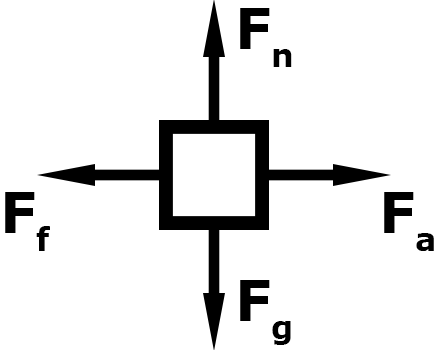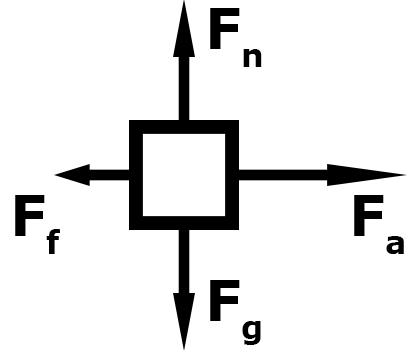Learn
Forces
An object that is sitting still will remain in that position until some force is applied to it. A force is a push or a pull that causes an object's motion to change. A force can cause an object to:
- speed up
- slow down
- or change direction, like up, down, left or right
The unit of measurement for force is a Newton (N), which is a kg x m/s2.
Think about a soccer ball. Until you apply a force to make the ball move, it will remain motionless. When you make contact with the ball, the force is called a contact force.
- You could kick it softly, setting the ball into slow motion. This is called a low force.
- You could kick harder, sending the ball moving quickly across the field. This is called a greater force.
A force can cause:
- Positive acceleration (we call this acceleration)
- Negative acceleration (we tend to call this deceleration)

Net Force
Most of the time, forces are applied on an object from different directions. When two or more forces act on an object at the same time, the forces can combine to form a net force. The net force is the sum of all the forces acting on an object at the same time. Since force is a vector, it has a magnitude and a direction.
Balanced and Unbalanced Forces
Forces being applied to objects can be balanced and unbalanced.
Balanced Forces
In balanced forces, the net force on an object is zero because the forces cancel each other.
- Pushing in opposite directions with the same amount of force is an example of balanced forces. The forces cancel each other out because they are equal and in opposite directions.
- Balanced forces do not cause a change in motion.

Notice in the image of tug of war above, the forces are equal and in opposite directions. The forces cancel each other; therefore the net force is zero.
Unbalanced Forces
In unbalanced forces, the net force on an object is not zero.
- The forces are added together or combined.
- The forces can be in the same direction or opposite directions.
A rocket is an example of an unbalanced force.

As shown in the image above,
- As the rocket is thrust upward, the weight of the rocket is in the downward direction.
- Since the thrust upward is greater than the weight downward, the rocket is launched upward into space.
Force Diagrams or Free Body Diagrams
We know that forces are applied on an object from different directions. We use force diagrams to easily visualize the directions of these forces. A force diagram, which is also called a free body diagram, shows how an object is affected by forces.
Balanced
Let's say we have a soccer ball and it is kicked to the right. To show this in a force diagram, we can follow the steps below. Our finished product will be a balanced free body diagram depicting a force being applied to an object in the rightward direction at a constant velocity.

- First, we draw a square for the object, which represents the soccer ball in this example.
- Next, we can address the applied force, Fa, which is the force making the object move. Since the applied force is coming from the right, the arrow representing Fa is drawn towards the right.
- When objects move, there is friction (we will cover friction more in the next lesson). To show the friction force, represented by Ff, draw another arrow in the opposite direction of the applied force arrow.
- Notice that when an object has constant velocity, both vector arrows (the Fa and Ff) are the same length. This means the forces are balanced.
- When an object sits on top of another object, the top object exerts a force on the bottom object and vice versa. Since the soccer ball sits on the ground, it exerts a force downward toward the ground; we call this the gravitational force, which is represented by Fg. This is also known as force of weight, or Fw.
- The ground exerts an equal force upward toward the soccer ball; we call this the normal force, or FN. When an object is not moving up or down, the normal force (FN), and gravitational force, Fg, are balanced.
NOTE: The force of gravity is always exerted toward the ground even when the object is in the air. When objects are in the air, there is not a normal force, FN, to oppose the gravitational force.
Unbalanced
Below is an example of an unbalanced free body diagram depicting unbalanced forces. Notice the similarities and differences with the previous diagram.
- The normal force and gravitational force are the same.
- The difference is that there is a greater applied force that indicates the object is accelerating; therefore, the friction force is less.


